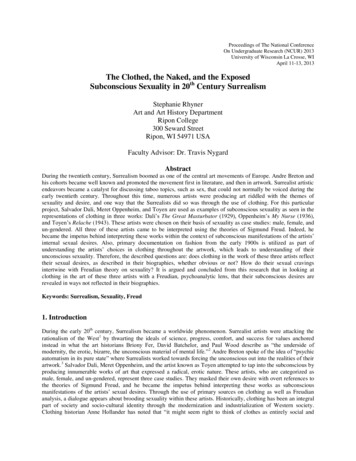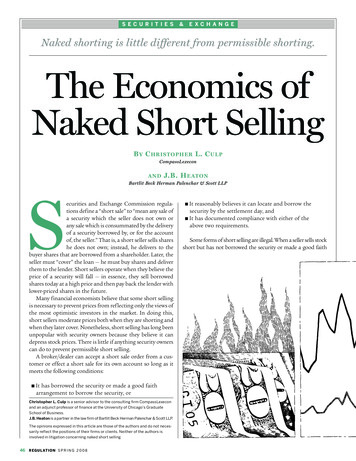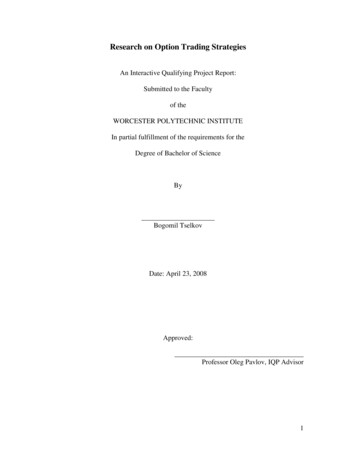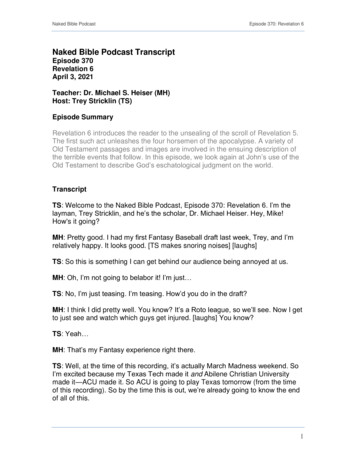
Transcription
Proceedings of The National ConferenceOn Undergraduate Research (NCUR) 2013University of Wisconsin La Crosse, WIApril 11-13, 2013The Clothed, the Naked, and the ExposedSubconscious Sexuality in 20th Century SurrealismStephanie RhynerArt and Art History DepartmentRipon College300 Seward StreetRipon, WI 54971 USAFaculty Advisor: Dr. Travis NygardAbstractDuring the twentieth century, Surrealism boomed as one of the central art movements of Europe. Andre Breton andhis cohorts became well known and promoted the movement first in literature, and then in artwork. Surrealist artisticendeavors became a catalyst for discussing taboo topics, such as sex, that could not normally be voiced during theearly twentieth century. Throughout this time, numerous artists were producing art riddled with the themes ofsexuality and desire, and one way that the Surrealists did so was through the use of clothing. For this particularproject, Salvador Dali, Meret Oppenheim, and Toyen are used as examples of subconscious sexuality as seen in therepresentations of clothing in three works: Dali’s The Great Masturbator (1929), Oppenheim’s My Nurse (1936),and Toyen’s Relache (1943). These artists were chosen on their basis of sexuality as case studies: male, female, andun-gendered. All three of these artists came to be interpreted using the theories of Sigmund Freud. Indeed, hebecame the impetus behind interpreting these works within the context of subconscious manifestations of the artists’internal sexual desires. Also, primary documentation on fashion from the early 1900s is utilized as part ofunderstanding the artists’ choices in clothing throughout the artwork, which leads to understanding of theirunconscious sexuality. Therefore, the described questions are: does clothing in the work of these three artists reflecttheir sexual desires, as described in their biographies, whether obvious or not? How do their sexual cravingsintertwine with Freudian theory on sexuality? It is argued and concluded from this research that in looking atclothing in the art of these three artists with a Freudian, psychoanalytic lens, that their subconscious desires arerevealed in ways not reflected in their biographies.Keywords: Surrealism, Sexuality, Freud1. IntroductionDuring the early 20th century, Surrealism became a worldwide phenomenon. Surrealist artists were attacking therationalism of the West by thwarting the ideals of science, progress, comfort, and success for values anchoredinstead in what the art historians Briony Fer, David Batchelor, and Paul Wood describe as “the underside ofmodernity, the erotic, bizarre, the unconscious material of mental life.” 2 Andre Breton spoke of the idea of “psychicautomatism in its pure state” where Surrealists worked towards forcing the unconscious out into the realities of theirartwork.3 Salvador Dali, Meret Oppenheim, and the artist known as Toyen attempted to tap into the subconscious byproducing innumerable works of art that expressed a radical, erotic nature. These artists, who are categorized asmale, female, and un-gendered, represent three case studies. They masked their own desire with overt references tothe theories of Sigmund Freud, and he became the impetus behind interpreting these works as subconsciousmanifestations of the artists’ sexual desires. Through the use of primary sources on clothing as well as Freudiananalysis, a dialogue appears about brooding sexuality within these artists. Historically, clothing has been an integralpart of society and socio-cultural identity through the modernization and industrialization of Western society.Clothing historian Anne Hollander has noted that “it might seem right to think of clothes as entirely social and
psychological phenomena, as tangible as three-dimensional emotions, manners, or habits.”4 During the time periodthese artists were working within, European and American fashion were mirroring each other, as a result ofglobalization. Therefore, using American primary documentation helps in contemplating the fashion being worn inthe European countries as well. In looking at clothing within these three case studies, the unseen sexual desires thatmanifest themselves in artistic expression appear in the way that artists perceive clothing and what that means to theartists themselves. In this context, Surrealist endeavors become a catalyst for speaking about gender and sexuality ina way that otherwise could not be found in the early twentieth century and which still is germane today.2. Salvador Dali’s Rape Of VeritiesPainted by Dali in 1929, The Great Masturbator (Figure 1) features what appears to be a female form, whose ownbody is covered by an abstract portrait of Dali, which he used in other paintings such as The Persistence of Memory(1931). This portrait encapsulates the woman’s frame, hiding all of her anatomical body parts. Her face is thengracefully lifting towards the clothed male genitalia, as if about to perform a sexual act. The male figure is clothedin a pair of small underwear, hiding his unerect penis. What does this painting say about Dali’s life and sexuality?Salvador Dali was born in 1904 in Spain and as a young boy, he “began to use his mother’s cosmetics as well asbiting his lips to make them appear red.”5 He quite fervently said that he loved women and that they were“miraculously beautiful,”6 however, his queer persona burst upon the scene when he described his “false memories”in his biography. These memories involved him having relationships with a boy named Buchaques and a girl namedGaluchka at a young age. Even throughout his life, Dali had an atypical relationship with his wife, Gala, who hemarried in 1934. Dali tried to impress her with affection by putting flowers in his hair and painting his entire bodywith blood and fish glue. Dali even stated that he “became her newborn, her child, her son, her lover.”7 However,Gala was not Dali’s only sexual relationship. According to the book Federico Garcia Lorca and the culture of malehomosexuality, Dali hid a homosexual relationship from the world. According to accounts and accusations made byAlain Bosquet, “Lorca was very much in love with [Dali]” and the painter had explicitly said: “‘one day I gave in tohis desires. We tried it It hurt me and we had to stop.’” 8 Sex, Surrealism, Dali and Me: The Memoirs of CarlosLorzano records another homosexual relationship between Dali and Carlos Lorzano, where it stated that Dali “likedto watch. He liked to masturbate. And, sometimes, though not often, he liked to do both at once.”9The Great Masturbator speaks directly to Dali’s described homosexual tendencies in the context of clothing. Firstof all, this woman is completely clothed in Dali’s own portrait, hiding her anatomical body and anything that couldbe considered sexual about her. She is also covered in Dali’s facial portrait, which creates this “woman” figure asbeing draped in a male countenance. This symbol of a silhouette, according to articles on Dalian symbols, stated thatthey stand not only for “psychological shadows” but also “inner conflicts and inhibitions, imagination, fantasy, anddreams.”10 The bleeding of the knees, and the locust (which Dali was extremely afraid of) symbolize fear andinhibitions, but not as forcefully as the portrayal of clothing on these figures. However, the clothed aspect thatstands out the most is a white pair of shorts, which hides Dali’s overtly unerect penis. Dali is not only hiding herbody, but shielding himself from sexual contact with her.Under the identification of the piece of clothing as male underwear, the historic significance becomes relevant.During this time period, men’s underwear was being revolutionized from a type of long underwear, to a type of briefthat was tighter and more convenient.11 In 1911, the revolutionary and controversial ad was released created by J.C.Leyendecker of the Cooper Bennington Union suit, which was called “Man on a Bag” (Figure 2). This began to cropup everywhere in advertisements and all over the world as the new way to see men’s underwear, as seen in thisadvertisement (Figure 3), which eventually lead to shorter, smaller briefs for men beginning in the 1910s-1920s.Shaun Cole expressed in his article “Considerations on a Gentleman’s Posterior,” that advertising in this mannerwith the male posterior on display raised homosexual fears of over sexualizing the male figure.12 Theseadvertisements become relevant to the discussion of Dali’s piece, which came out 16 years after these revolutionarychanges were being made to male undergarments. What, if anything, does this historical information present aboutDali and his subconscious?This painting hints at an inner unconscious sexuality that was being concealed from conventional society. Freud’swork itself became part of bashing homosexual desires as well as a criticism of sexuality that was common at thetime. Freud even went as far as to say in his work Three Contributions to the Sexual Theory that these people were“called contrary sexual, or better, inverts; that is there form the actualities of inversion.” 13 Part of the early 1900sinvolved a society that did not accept homosexuality or any stray from “typical” sexuality norms. Freud even saiddirectly in one of his texts that for those who were sexual inverts (homosexuals) “masturbation is quite as frequentlytheir exclusive aim, and it is ever true that restrictions on sexual aim.”14 Masturbation has frequently been734
condemned sexually and not discussed as normative. It was “even more strongly condemned than heterosexualexcess: it was said to lead to a whole range of diseases, including insanity, not only in the practitioner, but even inhis descendants.”15 This appearance of the clothing covering his genitals, coupled with the covering of the female,points to Dali hiding his homosexual lifestyle. Although Dali himself is a difficult character to understand andperceive, his paintings and biographical information released by others, demonstrate these homosexual tendencies.3. Meret Oppenheim’s Constroversial LustWhile Dali continued his work with controversial homosexual images, Meret Oppenheim was making ones of herown. The most illuminating of all the pieces she created on sexuality is My Nurse (1936), also called Magouvernante (Figure 4). This image presents two, white women’s shoes, which “are tied together and presented likea cooked goose on a platter.”16 These shoes, which sit upside down on the glistening platter, are frozen in time,unable to move. What did this simple sculpture of two shoes say about Oppenheim?Just like Dali, Meret Oppenheim’s obsession with dreams and sexuality was part of her everyday existence, evenas a child. Born in Germany in 1913, she “began to keep a record of her more important dreams – a custom sheretained throughout her life.”17 Not only was she part of a distinct psychoanalytic tradition, but she was alsoinfluenced by her grandmother, a vocal suffragette.18 In the United States, women were just beginning to gain theright to vote, while women’s suffrage in Europe would not be attained until 1971. As her career began in 1936 withthe creation of Le dejeuner en fourrure, so did the world’s controversial view of her. In the 1930s, Oppenheim wasphotographed by Man Ray, who challenged her sexuality as a frilly, female creature. The photographs featuredOppenheim “naked beside an etching press in the studio of painter Louis Marcoussis [which bespoke] the doublebind of women artists within surrealism.”19 These photographs were released in 1934 as part of this Veiled Eroticseries by Man Ray. Oppenheim had created this “blurring of gender boundaries [which] attained heightenedvisibility in the androgynous icon of the New Woman,”20 emphasizing a type of gender reversal. The most wellknown of the images, (Figure 5), shows Oppenheim standing behind the cast iron printing press, while “the handle,in particular, arms the female body with a detachable phallus, a pointer to the ways in which the privileged signifierof sexual difference was now ‘up for grabs.’” 21 Surrealism itself had had difficulties in promoting equality, as “itsmetaphors were erotic, its attitudes misogynist.”22 She hoped that in “playfully avoid[ing] a model that privilegedthe male gender,”23 that she had created a new sect in Surrealism that respected the female gender.My Nurse, which is often compared with The Couple (1956) (Figure 6), stands as an example of Oppenheim’sdrive to promote feminist intentions in clothing. The 1920s fashion world, according to Hollander, was well knownfor its “shoes [that] had higher heels then ever” 24 and the idea that “comfort in clothing is a mental rather thanphysical condition.”25 Even in a Sears, Roebuck and Company catalog, this company displayed shoes stating thatwomen could now be “walkers with a youthful flair.”26 The implications of these shoes were that “women are notsupposed to move; they should stand still and do what they are told,”27 which were ironic with the Sears, Roebuckand Company catalog statements that they were “light weight foot freedom.” Scholars state that My Nurse “seems towork within the framework of fetishism, and to suggest some form of entrapment.”29In 1982, Oppenheim would go on to explain My Nurse in her own words, stating “that this object ‘evokes for methe association of thighs squeezed together in pleasure. In fact, almost a “proposition.’”30 Oppenheim also associatedthese shoes with a nursemaid she had as a child. However, Oppenheim did not use nurses’ shoes to create this piece.Images such as (Figure 7) show images of typical female nurse uniforms from the early 1900s during World War I,and their clunky, awkward shoes. Oppenheim’s shoes are dainty and that everyday women of the early 1900s wouldhave worn. She was not attempting to necessarily represent any particular “nurse” or “nursemaid,” but to insteadevoke and speak to the larger population of women who were under this sexual and fashionable submission.Within the context of the photos by Man Ray, Oppenheim would be interpreted by Freud as having penis envy,which represented the desire for females to have their own penis and to admit “the superiority of the male and herown inferiority.”31 This, of course, was destroyed when Oppenheim represented herself as having a penis, equalizingherself to her male counterparts. Freud also comes into play with Oppenheim’s My Nurse. In his 11th volume, hewrites a section so called “Taboo Virginity.” Freud describes a woman who is placed in “sexual bondage,” whichdescribes “the phenomenon of a person’s acquiring an unusually high degree of dependence and lack of self-reliancein relation to another person with whom he has a sexual relationship.” 32 After this person has become part of this“bondage,” they lose all “independent will as far as causing a person to suffer the greatest sacrifices of his owninterests.”33 This bondage is represented as the two shoes are tied together. Within this fight for female sexualfreedom, Oppenheim promoted a feminist perspective, even as her qualities of beauty, youth, and rebellion “were735
stereotyped and stylized not only by the Surrealists but by art critics of the day, who barely gave mention toOppenheim’s work.”34 According to what is known about her personal life, she captivated the male Surrealist artists,such as Albert Giacometti, Man Ray, Kurt Sligmann, and she eventually married Wolfgang La Rouche. However,Oppenheim herself believed that gender was fluid and unstable,35 which was a theme in her artwork. Oppenheimwas part of a discourse that threatened males, and “lesbianism likewise [is] seen as threatening to male superioritybecause the women who engage in it appear not to need men.”36 Therefore, the ability to say that she had lesbiantendencies is still a topic open for further discussion.4. Toyen’s Genderless DeliveranceAs Oppenheim grappled with female sexuality during the Surrealist movement, Toyen, a self proclaimed“genderless” individual, produced innumerable works of art that were gender specific such as collages of femaleclothing (Figure 8) and also Relache, painted in 1943 (Figure 9). Relache meaning “‘respite’ or ‘relax’”37 holdsmany sparse images. A young girl hangs from a bar, with her body dramatically and unrealistic static in the air. Thefolds of her skirt hang over her head and her upper body, allowing only her torso and legs to be revealed. Thisominous setting with this girl of “pale virginal skin and props (sack and riding crop) frighteningly real and highlyevocative of what might be coming.”38 This image expresses a sense of mysterious innocence, especially with herwhite clothing trimmed in gold. What does this image say about Toyen’s sexual expression?Marie Cerminova, who named herself “Toyen,” was born in 1902 in the Czech Republic. “She turned her back onher family while still an adolescent, baptized herself with an obscure and genderless patronymic that may or may notderive from the French word for citizen, citoyen, and joined the anarchist milieu in Prague.”39 During this time, theCzech president had “asserted suffrage and equal educational rights for women in 1918 that helped to change therole of women in the Czech society.”40 Toyen became “the first woman artist who broke into the bastions of maledominated artistic circles.”41 She was fascinated with Surrealism and became part of this movement, dramaticallyrepresenting female sexuality and taboos. In the Czech Republic, many artists were focused upon “early twentiethcentury sex-reformist efforts”42 in which they had gained interest in sexuality, including “contraception, abortion,venereal diseases, marriage counseling, divorce laws, and rights for unwed mothers and their children and forhomosexuals.”43 Toyen, along with this group, were fighting against a European ideal of Surrealism, where Breton“had claimed in 1928 that he opposed homosexuality.” 44Through this, Toyen’s sexuality as a “female” was considered nonexistent. During the artist’s early work in 1922,she had “claimed an attraction to women, and was both very popular with and an object of unrequited love amongher male peers.”45 However, after a few years, she decided she lacked a gender, “appropriating the gender neutralpseudonym and referring to herself as ‘he,” the artist often wore men’s suits.” 46 However, over time numerousscholars have attempted to recreate her heterosexual persona, stating that she was married to her artistic partnerJindrich Styrsky. Nevertheless, the majority still believe in her desire to remain sexless, as she thwarted ideals thatsexuality is “‘natural,’ innate, and instinctual.”47 However, “secretive about any actual sexual relationships she mayhave had with either men or women, she was never secretive about desire itself Toyen explored themes of sexualfantasy and transgression, presenting viewers with scenes of orgies, lesbian encounters, [and] phallic toys.”48In Toyen’s day and age, just like Dali’s, underwear for women had experienced a drastic change with theappearance of the flapper who could no longer live with the crotchless, baggy underwear of the nineteenth to earlytwentieth centuries (Figure 10). Therefore, more fitted underwear became part of the new female wardrobe. Corsetsmade a famous reappearance as they were “simply remodeled; pressure was applied by tough elastic material ratherthan wholly by steel and canvas.”49 These girdles (Figure 11) would continue to be highly popular until the 1950sand were even ridiculously described by the Sears, Roebuck and Company Catalogue as being “comfortable supportplus freedom of action.”50In much of Toyen’s work during this time period, she was using “female attire [to] signify the female body andfemale sexuality”51 especially with floating garments and “stressing emptiness, fragmentation, and a sense ofphantasmatic horror.”52 In Relache, Toyen chose to depict one of the less popular pieces of underwear during thistime, which was a more simple form of underwear with a loose fitting camisole so that the image of the femalecreature is covered up, disguising her sexuality. These sexual garments were much less obvious as being “female,”except for the small golden “dainty lingerie details”53 and flowing lace. So, although female sexuality is implied, itis also covered by the clothing, which relates back to Toyen disguising her own female sexuality, even in her choiceof more sexless underwear for the time period. In this way, she recombined and re-gendered the figure54 showingher own sexual idealization.736
In this context, Toyen stands as an artist who delved into female and male sexuality, while she avoided definingherself. She took pleasure in all parts of the body, including the phallic object on many occasions, but mostly shefocused on the female body. Freud discussed “a woman who has felt herself to be a man, has loved in masculinefashion, will hardly let herself be forced into playing the part of a woman, when she must pay for thistransformation, which is not in every way advantageous.”55 For Freud and many of this time period, it wasconsidered perversion or neurosis56 to be considered outside the gender and Freud described a group of people whohad a “kind of inversion [that] lacks the characteristic of exclusiveness.”57 Toyen’s sexuality is hidden by these silkgarments that promote an ungendered creature lying underneath.5. Discussion And ConclusionSexuality within Surrealism is constantly being revealed and revisited as the sexuality of those involved becomesexposed and reinterpreted. Salvador Dali, Toyen, and Meret Oppenheim hid their sexuality in a time when it wasdifficult to express their true sexual intentions. Dali and his painting The Great Masturbator would have beeninterpreted by Freud as part of the realm of homosexuality and inversion, seen even through early twentieth centuryadvertisements. Meret Oppenheim and My Nurse would have been seen by Freud as generally part of female culturefighting against a male dominated artistic field, and specifically as part of lesbian culture. And, finally, Toyen wouldhave been considered by Freud as a genderless being, unwilling to admit her hidden sexuality to others, as seenthrough her painting Relache and many other works of art. These sexualities, as interpreted by Freud, stayed hiddenfor many years in these paintings derived from pure automatism and the unconscious strokes. In the context of thesepaintings, clothing itself is a metaphor for the body and inner persona as all of these artists utilized this motif as away to express their unconscious sexuality, whether obvious to them at the time or not. Surrealism would continueto blossom until the 1950s, when it began to diminish in popularity. Although these artists continued to make worksof art, the movement faded from Europe as others took its place. However, Surrealism left its lasting impression onthe world and its sexual nature would not be forgotten or ignored.6. ImagesFigure 1. Salvador Dali, The GreatMasturbator, 1929Figure 2. J.C. Leyendecker, “Man ona Bag” Advertisement for CopperBenninton Union Suit, 1911737Figure 3. Ad PoroskintUnderwear for ChalmersKnitting Clothes, 1910
Figure 4. Meret Oppenheim,My Nurse, 1963Figure 5. Man Ray FeaturingMeret Oppenhim, VeiledErotic Series, 1934Figure 7. WW! Nurse’s Uniform,with capeFigure 8. Toyen Clothing Collage738Figure 6. Meret Oppenheim,The Couple, 1956Figure 9. ToyenRelache, 1943
Figure 10. Crotchless Underware, 1800-Early 1900sFigure 11. Girdle, 1930s7. Notes Matthew Gale, Dada & Surrealism, London: Phaidon Press, 1997.2 Briony Fer, David Batchelor, and Paul Wood, Realism, Rationalism, Surrealism: Art Between the Wars,London: The Open University, 1993, 239.3 Andre Breton, “The First Manifesto of Surrealism,” In Art In Theory (1900-2000): An Anthology of ChangingIdeas, edited by Charles Harrison and Paul Wood, 447-453, United Kingdom: Blackwell Publishing, 2003, 452.4 Anne Hollander, Seeing Through Clothes, New York: The Viking Press, 1978, xv.5 Sherry Babbit, “On the Verge of Greatness: A Look at the Young Salvador Dali,” Tampa Bay Magazine: TheBest of Tampa Bay, July/August 1995, 32.6 Salvador Dali, The Secret Life of Salvador Dali, New York: Dial Press, 1942, 12.7 Jennifer Mundy, et al, Surrealism: desire unbound, New Jersey: Princeton University Press, 2011, 149.8 Erica Frouman-Smith and Angel Sahuquillo, Federico Garcia Lorca and the culture of male homosexuality,North Carolina: McFarland & Company, Inc., 2007, 19.9 Clifford Thurlow, Sex, Surrealism, Dali and Me: The Memoirs of Carlos Lorzano, Great Britain: Razor BooksLimited, 2000, 59.10 “Dalinian Symbol,” Museum-Gallery XPO: Salvador Dali, Accessed September 3, 2012, http://www.daliinterart.be/pdf/DALI SYMBOLS.pdf.11 Shaun Cole, “Considerations on a Gentleman’s Posterior,” Fashion Theory: The Journal of Dress, Body &Culture 16.2 (2012): 211-234.12 Ibid.13 Sigmund Freud, Three Contributions to the Sexual Theory, New York: The Journal of Nervous and MentalDisease Publishing Company, 1910.14 Anna Freud, editor, “Three Essays on Sexuality: The Sexual Aberrations,” In The Complete PsychologicalWorks of Sigmund Freud, Volume VII (1901-05): A Case of Hysteria, Three Essays on Sexuality, and Other Works),135-172, London: The Hogarth Press and the Institute of Psychoanalysis, 1953, 145-146.15 Pat Caplan, The Cultural Construction of Sexuality, New York: Tavistock Publications Ltd, 1993, 4.16 Jacqueline Burckhardt and Bice Curiger, Meret Oppenheim: Beyond the Teacup, New York: IndependentCurators Incorporated, 1996, 51.17 Bice Curiger, Meret Oppenheim: Defiance in the Face of Freedom, New York: Parkett Publishers, Inc., 1989,9.739
18 Ibid.19 Mundy, Surrealism, 224.20 Ibid.21 Ibid.22 Burckhardt, Meret Oppenheim, 35.23 Ibid., 41.24 Hollander, Seeing Through Clothes, 339.25 Ibid.26 Sears, Roebuck and Company, Sears, Roebuck and Co. Fall and Winter 1946/47, Chicago: Sears, Roebuckand Company, 1946/47, 399.27 Burckhardt, Meret Oppenheim, 51.29 Fer, Realism, Rationalism, Surrealism, 239.30 Mundy, Surrealism, 45.31 Anna Freud, “Female Sexuality,” In The Complete Psychological Works of Sigmund Freud, Volume XXI(1927-31): The Future of an Illusion: Civilization and It’s Discontents and Other Works, 221-243, London: TheHogarth Press and the Institute of Psychoanalysis, 1964, 229.32 Anna Freud, “The Taboo of Virginity,” In The Complete Psychological Works of Sigmund Freud, Volume XI(1910): Five Lectures on Psychoanalysis, Leonardo Da Vinci, and Other Works, 191-208, London: The HogarthPress and the Institute of Psychoanalysis, 1964, 193.33 Ibid.34 Burckhardt, Meret Oppenheim, 25.35 Mundy, Surrealism, 224.36 Caplan, The Cultural Construction of Sexuality, 2.37 Margaret Barlow, Women Artists, New York: Universe, 1998, 200.38 Ibid.39 Whitney Chadwick, Women Artists and the Surrealist Movement, Boston: Little, Brown and Company, 1985,115.40 Martina Pachmanova, “Toyen (1902-1980), Sexuality, Desire, Identity,” Zeny Gender & Moderni Umeni, Lastmodified 2008. http://www.zenyvumeni.cz/index.php?id 70/, 1.41 Ibid.42 Karla Huebner, “Fire Smoulders in the Veins: Toyen’s Queer Desire and Its Roots in Prague Surrealism,”Papers of Surrealism 8 (Spring 2010): 1-22, 8.43 Ibid.,17.44 Ibid., 17.45 Ibid., 8.46 Pachmanova, “Toyen (1902-1980)”, 1.47 Caplan, The Cultural Construction of Sexuality, 3.48 Huebner, “Fire Smoulders in the Veins,” 2.49 Hollander, Seeing Through Clothes, 338-9.50 Sears, Roebuck and Company, Sears, Roebuck and Co. Fall and Winter 1946/47, 225.51 Huebner, “Fire Smoulders in the Veins,” 12.52 Ibid., 13.53 Sears, Roebuck and Company, Sears, Roebuck and Co. Fall and Winter 1946/47, 243.54 Huebner, “Fire Smoulders in the Veins,” 32.55 Anna Freud, “The Psychogenesis of a Case of Homosexuality in a Woman,” In The Complete PsychologicalWorks of Sigmund Freud, Volume XVIII (1920-22): Beyond the Pleasure Principle Group Psychology and OtherWorks, 147-172, London: The Hogarth Press and the Institute of Psychoanalysis, 1955, 172.56 Anna Freud, The Complete Psychological Works of Sigmund Freud, Volume XVI (1916-17): IntroductoryLectures on Psycho-Analysis (Part III), London: The Hogarth Press and the Institute of Psychoanalysis, 1963.57 Anna Freud, “Three Essays on Sexuality,” 136.740
Salvador Dali’s Rape Of Verities Painted by Dali in 1929, The Great Masturbator (Figure 1) features what appears to be a female form, whose own body is covered by an abstract portrait of Dali, which he used in other paintings such as The Persistence of Memory (1931). This portrait encapsu










